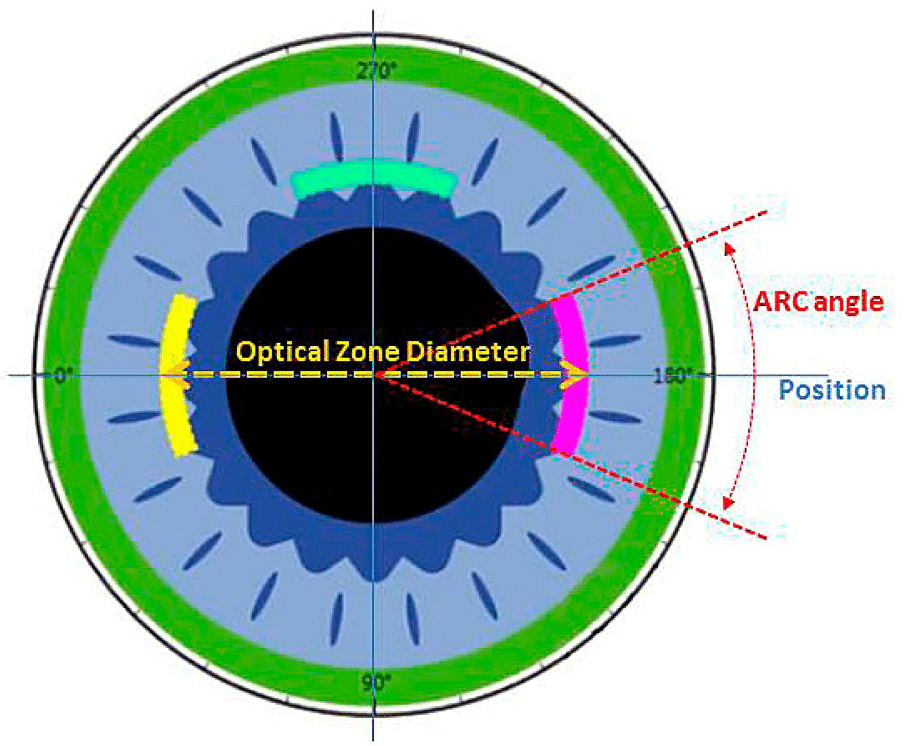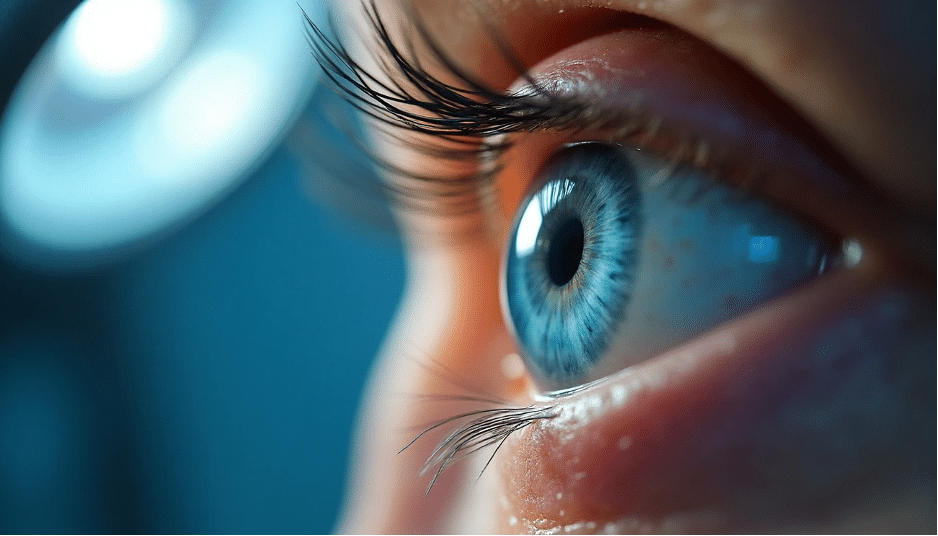Many patients ask me if cataract surgery can correct astigmatism. The answer is yes, and with good reason too. Astigmatism affects approximately 1 in 3 Americans. A systematic review revealed that preexisting astigmatism greater than 1.0 D showed up in 47% of eyes undergoing cataract surgery.
Modern eye surgery for astigmatism has made remarkable progress. Toric lenses for cataract surgery now effectively treat both conditions at once, with cylinder powers ranging from 1.5 D to 6.0 D. On top of that, it helps that limbal relaxing incisions provide another solution, especially when you have lower levels of astigmatism up to 1.5 D. Research shows impressive results – after astigmatism correction surgery, all but one of these patients needed spectacles for distance viewing.
This detailed guide will explain everything about cataracts and astigmatism. You’ll learn whether astigmatism can disappear with cataract surgery and what you should expect before, during, and after your procedure. Let’s see if cataract surgery will correct astigmatism in your case.
Why Astigmatism Matters During Cataract Surgery

Image Source: MDPI
Astigmatism plays a huge role in cataract surgery success, but doctors often skip it during pre-surgical planning. The numbers tell a clear story—nearly 35-40% of cataract patients have astigmatism ≥1.0 D and 19-22% have astigmatism ≥1.5 D. Your surgical outcomes can improve a lot by understanding what this means.
How uncorrected astigmatism affects daily life
Even a small amount of uncorrected astigmatism can hurt vision quality badly. Research shows visual acuity drops to 20/25 with just 0.75 D and 20/40 with 1.5 D of astigmatism. This blurry vision creates real-life challenges:
- Reduced independence: Reading and driving become harder each day
- Physical discomfort: Constant focusing leads to headaches and eye strain
- Psychological impact: Social situations become frustrating and confidence drops
A key study revealed that uncorrected astigmatism of just 1.00 D reduced vision enough to affect a patient’s independence and quality of life.
Astigmatism after cataract surgery: what to expect
Astigmatism usually gets worse after cataract surgery if left alone. Studies show it often deteriorates after the procedure without treatment. A typical cataract operation adds surgically induced astigmatism between 0.50 and 1.00 D based on the technique used.
Many patients end up disappointed with their vision even after successful cataract removal. This leftover astigmatism often means they need glasses unexpectedly, which makes them less happy with the results.
Benefits of correcting both conditions together
Fixing cataracts and astigmatism at the same time makes sense. Patients who get their astigmatism fixed during cataract surgery are happier and see better overall.
The money side looks good too. Toric IOLs cost more upfront but save money later by reducing the need for glasses and extra fixes. The numbers speak for themselves – only 29.7% of patients needed distance glasses after toric IOL implantation compared to 53.2% with regular lenses.
Better depth perception comes with fixing astigmatism, which helps reduce fall risks in older adults. Patients can drive at night more safely and comfortably thanks to better contrast sensitivity and less glare.
Choosing the Right Correction Method

Doctors must think over many factors to choose the best astigmatism correction method during cataract surgery. These factors include astigmatism severity, patient’s priorities, and eye anatomy.
Toric IOLs: A Look at Their Benefits
Toric intraocular lenses fix astigmatism right at its source with different powers in different meridians. These specialised lenses come with cylinder powers from 1.5 D to 6.0 D. They provide astigmatism correction of 0.75 D to 4.75 D at the corneal plane. Research shows these lenses work better in several ways. Patients who get toric IOLs see better without glasses, and only 29.7% need distance spectacles compared to 53.2% with non-toric options.
Yes, it is true that toric IOLs give the best results for pre-operative astigmatism between 1.0-3.0 D. Surgeons place the toric lens during cataract surgery and arrange it with the astigmatic axis. This option works great especially when you have higher astigmatism levels (>2.0 D) or want to reduce dependence on glasses.
The Right Time for LRIs
Limbal relaxing incisions are affordable options for mild to moderate astigmatism patients. LRIs create precise incisions at the limbus across the steep axis. This flattens that meridian while making the opposite one steeper. They usually correct up to 1.5 D of astigmatism, but can fix up to 3.0 D in some cases.
LRIs help patients who can’t get toric IOLs due to cost or availability. Studies also show that LRIs don’t cause big changes in corneal higher-order aberrations. This makes them a good choice for patients worried about their night vision quality.
What Clear Corneal Incisions Can and Cannot Do
Clear corneal incisions (CCIs) are the quickest way but come with limits. Standard CCIs on the steep axis usually fix only 0.5 D of astigmatism. The correction varies with incision size. Smaller 2.2 mm incisions correct 0.10 D while 3.0 mm incisions fix 0.32 D.
Surgeons sometimes use opposed clear corneal incisions (OCCI) – similar incisions placed 180° apart to boost results. Research shows single CCIs reduced astigmatism by 0.46 D, while OCCIs achieved 0.91 D reduction. But CCIs only work for mild-to-moderate astigmatism and have limits on where incisions can be made.
Want to see clearly without glasses after cataract surgery? Visit Precision Vision London today to explore your astigmatism correction options!
Planning for Surgery: What Patients Should Know
Success in astigmatism correction during cataract surgery depends on careful preparation. Eye surgeons know that planning matters just as much as the actual procedure. The process needs specific measurements and careful choices.
Pre-surgery eye measurements and imaging
Your eye measurements must be exact before cataract surgery that corrects astigmatism. Specialists take detailed measurements of your axial length, corneal curvature, and anterior chamber depth. These numbers help determine your toric IOL’s power and how it lines up.
Your surgeon will use several advanced tools:
- Optical biometry (e.g., Zeiss IOL Master 700) gives precise keratometric measurements
- Corneal topography creates maps of your corneal surface
- Corneal tomography looks at both front and back corneal surfaces
Results work best when you stop wearing contact lenses several days before measurements. Your surgeon might suggest treating dry eyes first to get more accurate readings.
How surgeons decide on the best approach
Your measurements go through specialised tools like the Barrett toric calculator that combines data from different devices. This shows the best toric IOL power and where to place it.
Surgeons check if your astigmatism is regular or irregular because toric IOLs only fix regular astigmatism. The posterior corneal surface adds about 0.30D of ATR astigmatism when eyes have anterior ATR astigmatism and 0.50D with WTR astigmatism.
Small ink marks on your cornea show the astigmatism axis on surgery day. This ensures the lens goes in the right spot.
What to ask your eye surgeon before the procedure
Here are key questions to ask your surgeon:
- What’s your experience with toric IOLs? (Most active surgeons do 15-30 cataract surgeries each week)
- Which lens works best for my astigmatism type?
- Will glasses be necessary after surgery? (Only 29.7% of patients needed distance glasses with toric IOLs)
- How do you measure and mark my astigmatism axis?
- What happens during follow-up care?
Ready for clearer vision without glasses after cataract surgery? Visit Precision Vision London to learn about your astigmatism correction options today!
Post-Surgery Vision and Long-Term Results
Recovery after astigmatism correction during cataract surgery differs among patients. Most patients see improved vision within days. The experience toward clear vision continues beyond the operating room.
How vision improves after astigmatism correction surgery
Your vision might appear blurry for a few hours after surgery because of pupil-dilating eye drops. Vision clarity typically improves within 3-4 days, though complete healing takes more time. Clinical studies show that patients receiving toric IOLs often achieve postoperative residual astigmatism of 0.5 diopters or less—optimal for visual acuity. Nearly 90% of patients who undergo procedures for myopic astigmatism achieve 20/20 vision or better within a year.
Patients report major improvements in their quality of life after surgery. They can now participate in daily activities without constant reliance on corrective eyewear. Toric lenses correct astigmatism and improve nighttime driving while increasing contrast sensitivity that results in better image quality.
Will you still need glasses?
The implanted lens type determines whether you’ll need glasses after surgery. Patients with monofocal lenses usually need reading glasses for close-up tasks, even with corrected distance vision. Studies reveal that only 29.7% of patients needed spectacles for distance viewing after toric IOL implantation, compared to 53.2% with non-toric lenses.
Premium multifocal lens recipients rarely use glasses, with 80-85% reporting minimal to no use. Most patients’ prescriptions change following cataract surgery. They should wait for their final post-operative check, usually four weeks after operation, before getting new glasses.
Managing expectations and follow-up care
Your surgeon will prescribe eye drops that help healing and prevent infection, typically needed for about 4 weeks. Regular follow-up appointments play a significant role, with your final check scheduled one month after surgery.
The thin membrane behind your new lens implant might become opaque during the first few months or years after surgery, creating a philtre-effect. This condition, called posterior capsule opacification (PCO), affects approximately 20% of patients. A simple YAG laser procedure can easily treat PCO to restore clear vision.
Final Thoughts on Astigmatism Correction During Cataract Surgery
My years as an eye surgeon have shown me how combining cataract and astigmatism correction revolutionises patients’ lives. Modern surgical techniques are a great way to get clearer vision. They help reduce dependence on corrective eyewear.
Your surgical trip starts with getting a full picture. Advanced imaging technology measures your corneal profile before surgery. These precise measurements matter by a lot because even small errors can affect your vision dramatically.
Your astigmatism severity determines the best correction method—toric IOLs, limbal relaxing incisions, or clear corneal incisions. Toric lenses work better for moderate to high astigmatism (above 1.5D). LRIs work well for milder cases. Toric IOLs might cost more upfront, but reduced dependence on glasses makes them worth the investment.
Most patients follow a predictable recovery pattern. Blurry vision clears up within days. Patience becomes vital during healing. Optimal results come within four weeks. Your brain might need several months to adapt fully. Will you need glasses after cataract surgery? Each case differs based on your eyes and lens choice. Studies show that glasses become nowhere near as necessary after astigmatism correction, especially for distance vision.
Several factors determine your final results. These include surgical technique, lens selection, and your eye’s healing response. Clear expectations and open talks with your surgeon lead to successful outcomes. Cataract surgery gives you a chance to fix astigmatism issues. This two-in-one approach restores clarity and could free you from astigmatism forever. Your vision deserves this complete care.
FAQs
Q1. Can cataract surgery completely eliminate astigmatism? While cataract surgery can significantly reduce astigmatism, complete elimination may not always be possible. The degree of correction depends on the severity of astigmatism and the chosen surgical method. Many patients experience substantial improvement, with studies showing that toric intraocular lenses (IOLs) can reduce astigmatism to 0.5 diopters or less in most cases.
Q2. How long does it take to recover from cataract surgery with astigmatism correction? Most patients notice improved vision within 3-4 days after surgery. However, complete healing and stabilisation of vision can take up to a month. Your surgeon will schedule follow-up appointments to monitor your progress, with the final check typically occurring about four weeks post-operation.
Q3. Will I still need glasses after cataract surgery that corrects astigmatism? The need for glasses after surgery depends on the type of lens implanted and your specific vision needs. With toric IOLs, only about 30% of patients require glasses for distance vision, compared to over 50% with standard IOLs. However, many patients with monofocal lenses may still need reading glasses for close-up tasks.
Q4. What are the different methods for correcting astigmatism during cataract surgery? The main methods for correcting astigmatism during cataract surgery are toric intraocular lenses (IOLs), limbal relaxing incisions (LRIs), and clear corneal incisions (CCIs). Toric IOLs are most effective for moderate to high astigmatism, while LRIs work well for milder cases. CCIs offer limited correction but can be useful for very mild astigmatism.
Q5. How do surgeons determine the best approach for correcting my astigmatism? Surgeons use advanced diagnostic tools like optical biometry, corneal topography, and tomography to precisely measure your eye’s characteristics. They analyse these measurements using specialised calculators to determine the ideal correction method and lens power. Factors considered include the degree and type of astigmatism, corneal shape, and your visual needs and preferences.
Authors & Reviewer
-
 Olivia: Author
Olivia: AuthorHi, I'm Olivia, a passionate writer specialising in eye care, vision health, and the latest advancements in optometry. I strive to craft informative and engaging articles that help readers make informed decisions about their eye health. With a keen eye for detail and a commitment to delivering accurate, research-backed content, I aim to educate and inspire through every piece I write.
-
 Dr. CT Pillai: Reviewer
Dr. CT Pillai: ReviewerDr. CT Pillai is a globally recognised ophthalmologist with over 30 years of experience, specialising in refractive surgery and general ophthalmology. Renowned for performing over 50,000 successful laser procedures.

